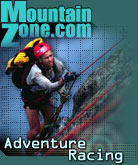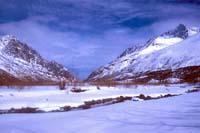
Yukon Death March
Freezing rain, mushy snow, and a new course pushed Alaska Ultra Sport racers to the limits of their endurance
Nome, Alaska - June 21, 2003

|
'Give Up Hope' reads a sign on my friend Pat Norwil's refrigerator. I knew what the Buddhists meant by it, but this year's Alaska Ultra Sport gave me another chance to further learn that lesson.
Three days into the race bad weather hit and I decided to hole-up in a remote trappers' cabin and wait for the trail to be broken--my short skate skis just weren't cutting it in the deep snow. But it didn't stop snowing and no snow machine came along to break the trail. It actually became quite a problem because it was snowing so much I thought I'd never make it out on narrow skis.
I remembered reading about the 1990 Iditasport, where it snowed one and a half feet the night before the race and on the starting line; everyone took off and proceeded to push their bikes through the deep snow for 28 straight hours. All but one that is--Bob Forney stopped at the first lodge and sat and waited until the next morning, then got on his bike and rode up to the entire field in a few hours because those people pushing had packed down the trail for him.
I had similar thoughts, except it never stopped snowing. I kept waiting for it to stop and for someone to break trail for me. The longer I waited the worse it got. And now I was in real trouble--more than 4 feet had fallen and literally I was getting snowed into this cabin!
| ||
Leading up to this race no one would have guessed we would get too much snow. Alaska had one of its warmest and snow-less winters on record while the east coast got buried weekly. Anchorage had no snow on the ground and the rivers were starting to break up. The Iditarod was forced to move its course north and so did the Alaska Ultra Sport. So after planning everything for the old route for the last 6 months everything changed with 2 weeks to go. I ran out and got maps and researched the new route. The race organizers did one hell of a job to pull off a completely new 350-mile route with very little time.
The new course was the Serum Run - the original route of the Iditarod dog sled race and the one that started all of these winter human and dog-powered events.
In 1925, Nome, Alaska had an outbreak of diphtheria, a potentially fatal infectious bacterial disease. The only antitoxin for it was 1100 miles away in Anchorage. All of the planes in the state (two) had been dismantled for the winter. They had a big problem. Without the serum the disease would spread rapidly though the children population. They had to get the antitoxin to Nome as quickly as possible. Then Governor Scott C. Bone decided on dog teams as the most reliable transportation. They sent the antitoxin by train to the end of the railroad in Nenanna, where it was picked up by the first dog musher. From there mushers relayed it in segments of 30-60 miles, exchanging at villages. The dogs got the antitoxin in Nome just in time and saved countless lives.
To get to the race start everyone boarded a chartered bus for the 7-hour trip. One of the race officials had everyone write short messages to friends or family back home. Mine was "I need to ski fast to get home to my beautiful pregnant wife." My wife Julie was back home in Seattle, 9 months pregnant - - needless to say, I had more reasons than just competitive drive to ski this race quickly and get home. On the starting line we were each loaded up with the first 100-miles worth of food and gear. Two food drops were scheduled over the 350 miles, one at Manley--mile 100 and the other at Tananna -- mile 160. I stocked my drops with my favorite non-freezing foods: nuts, halva, wasabi peas, M&Ms, butter, Ramen, shortbread cookies, and HydraGo electrolyte drink.
—By John Stamstad at www.singletrackranch.com
